
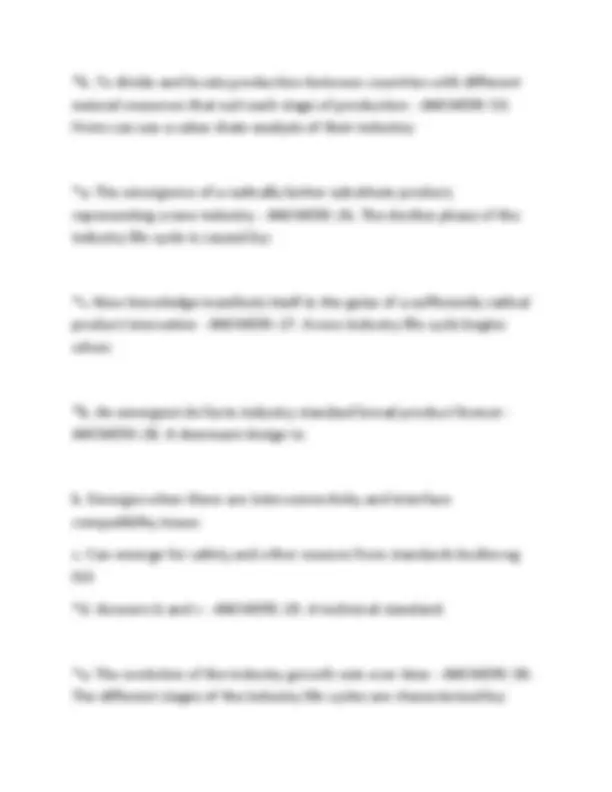
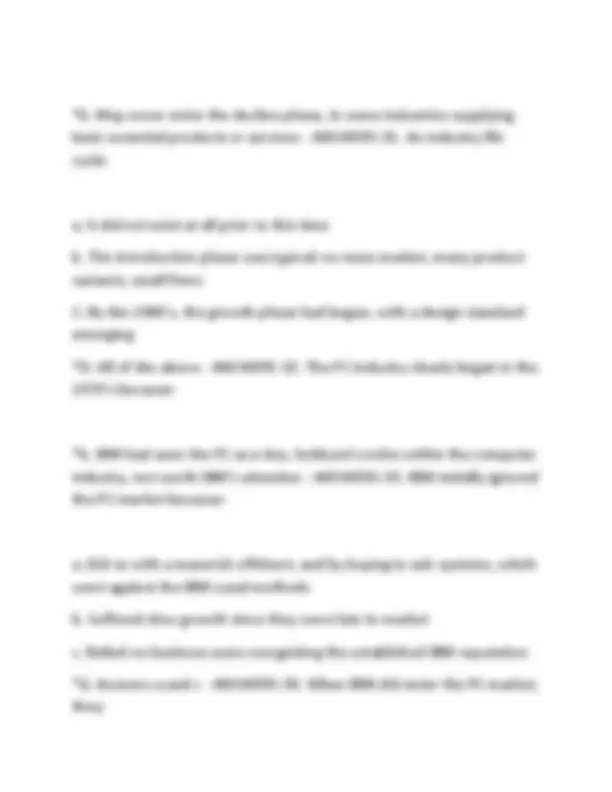
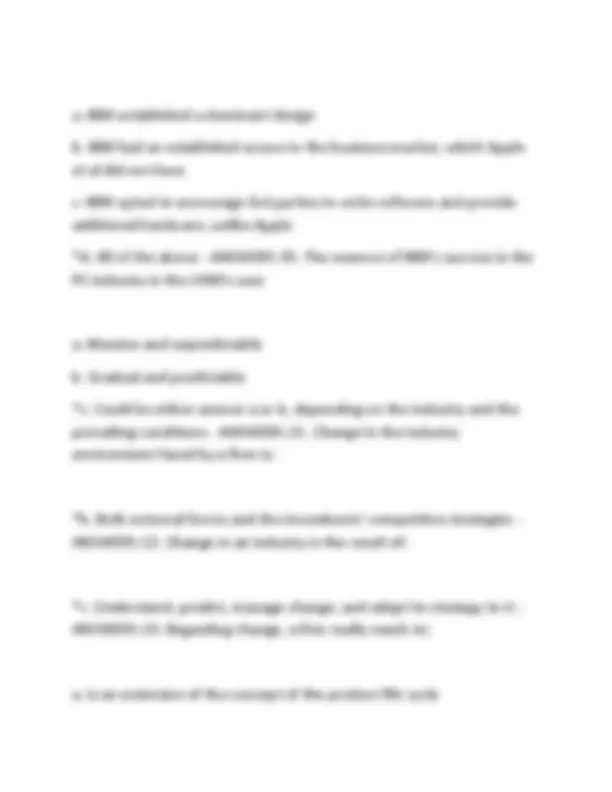
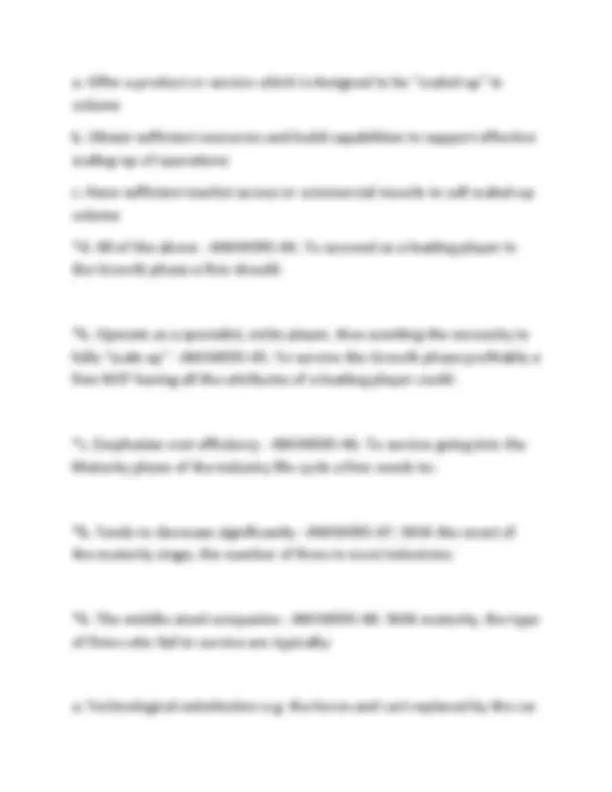
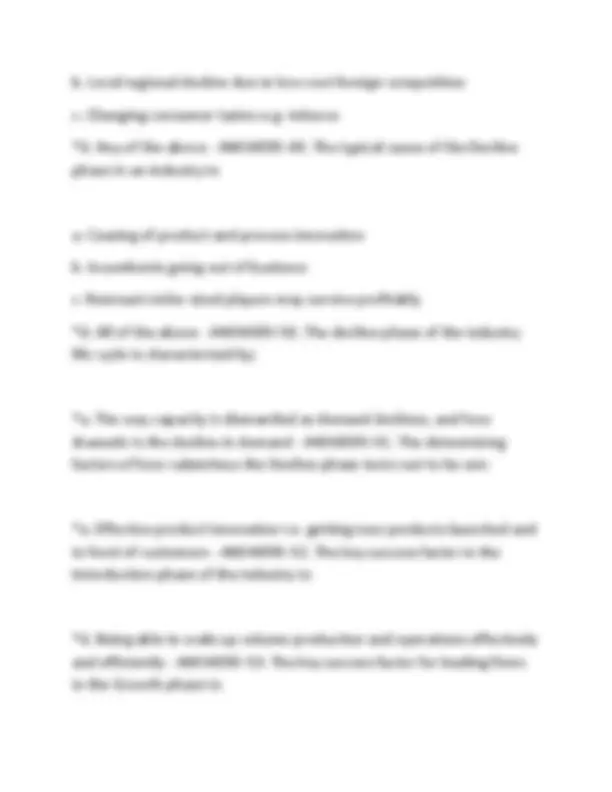
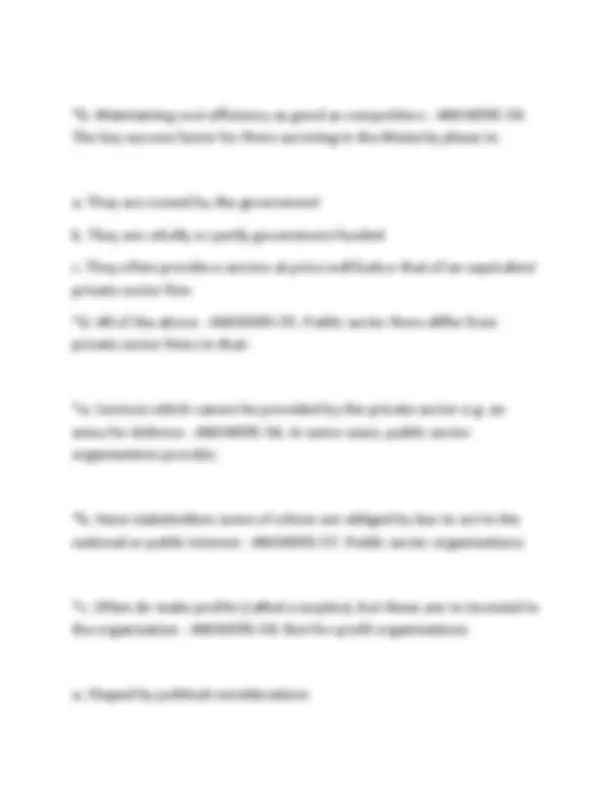
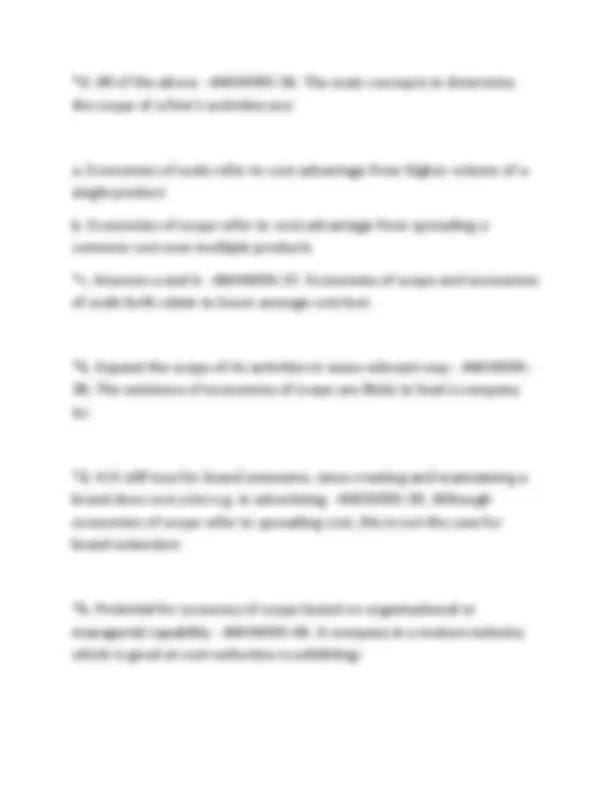
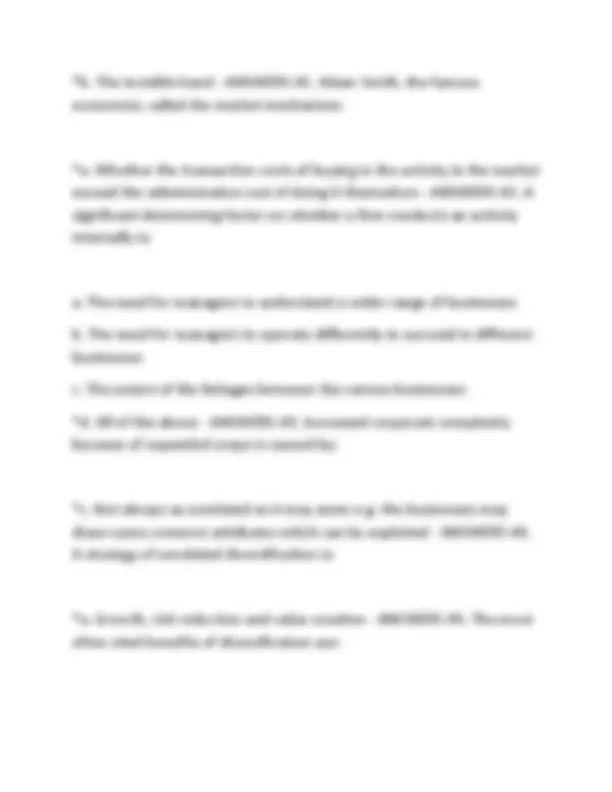
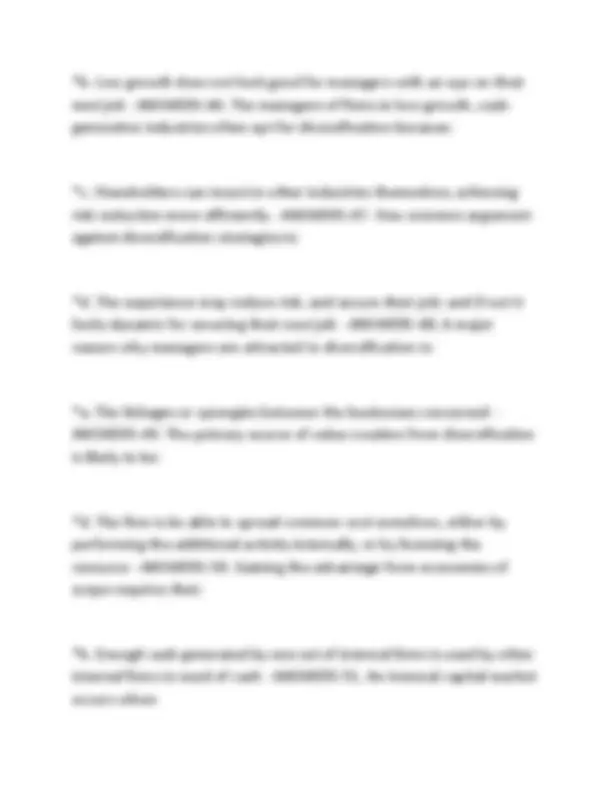
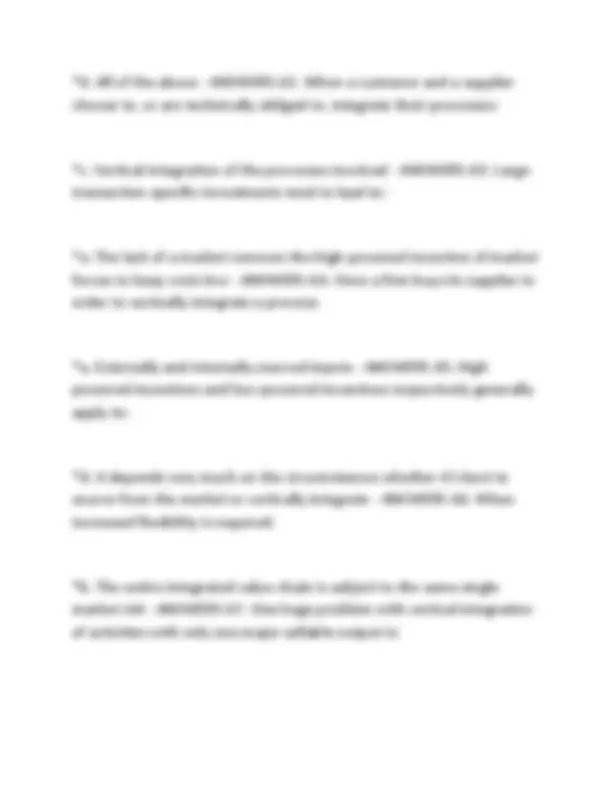
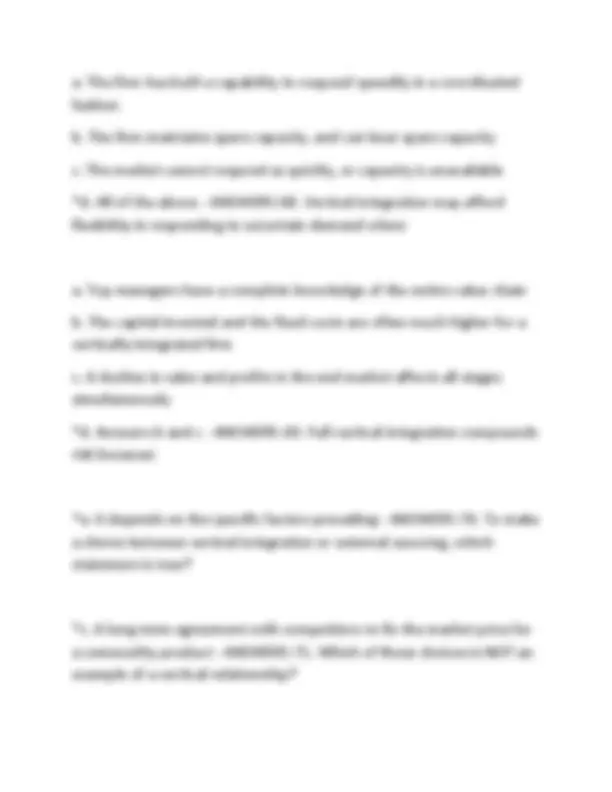
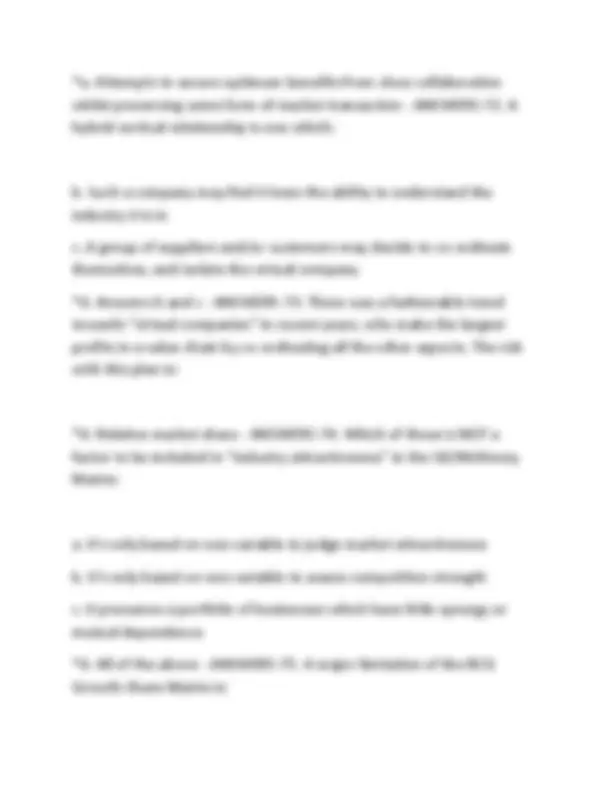
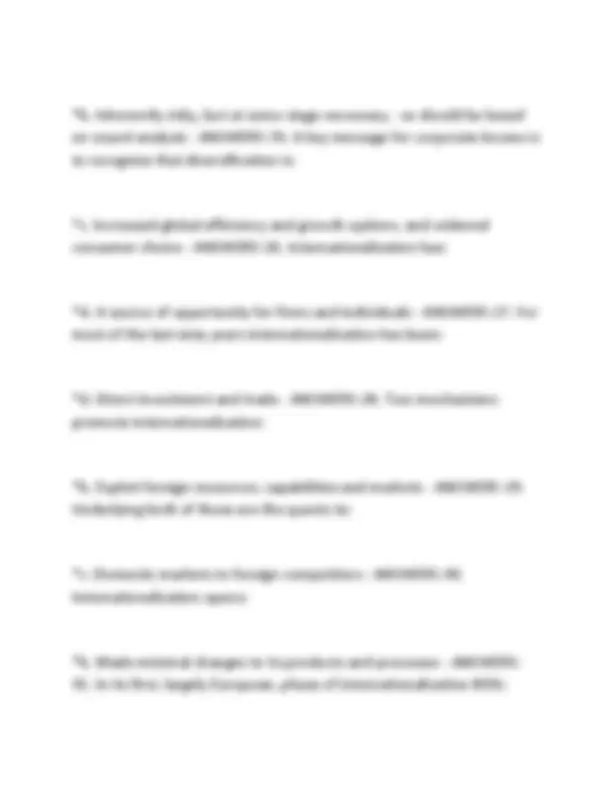
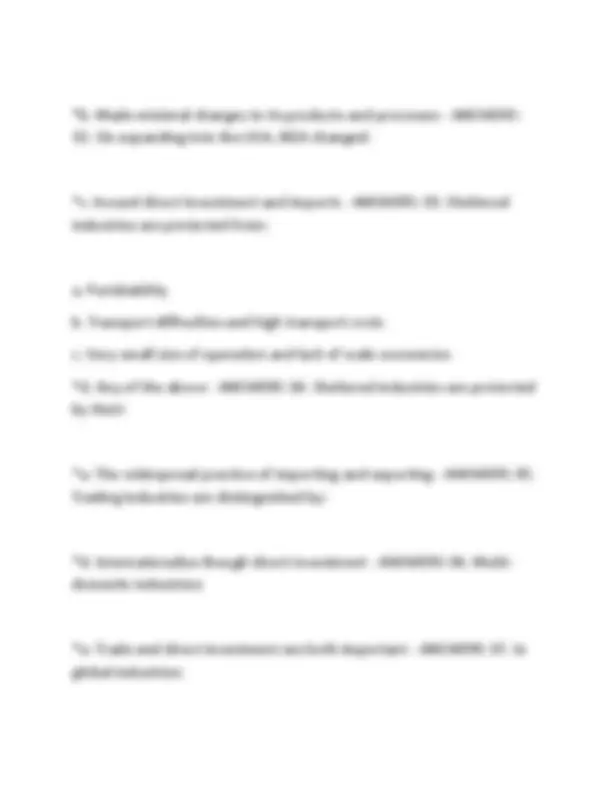
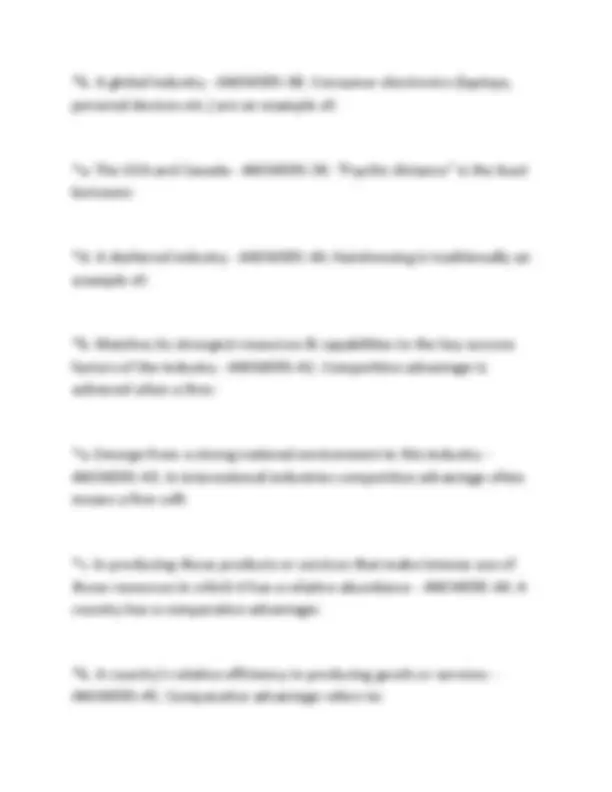
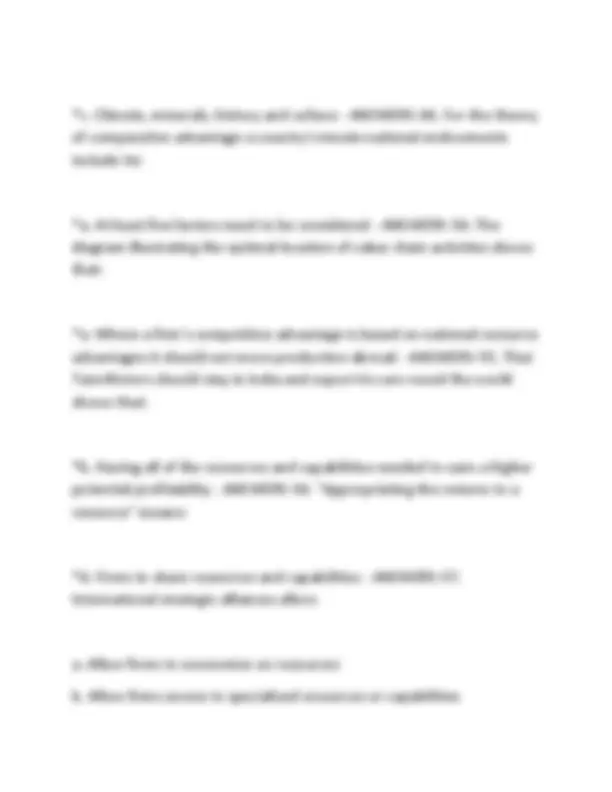
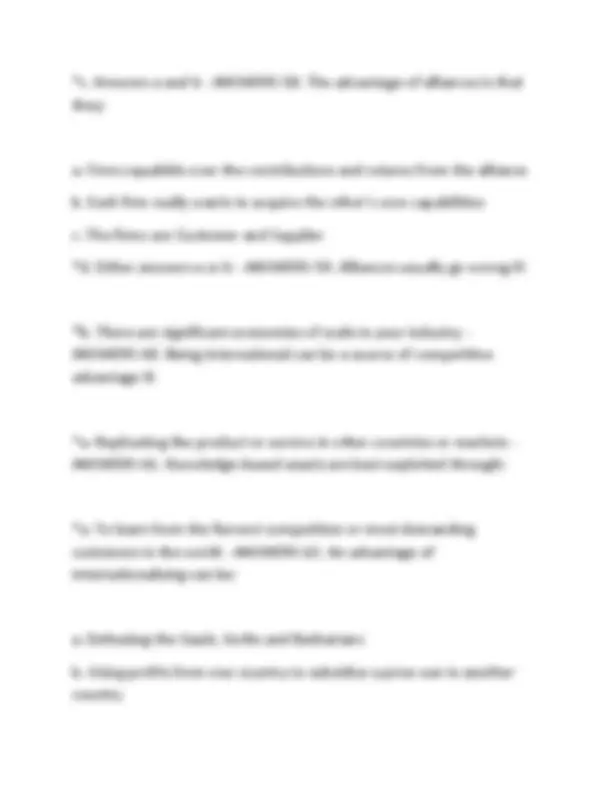
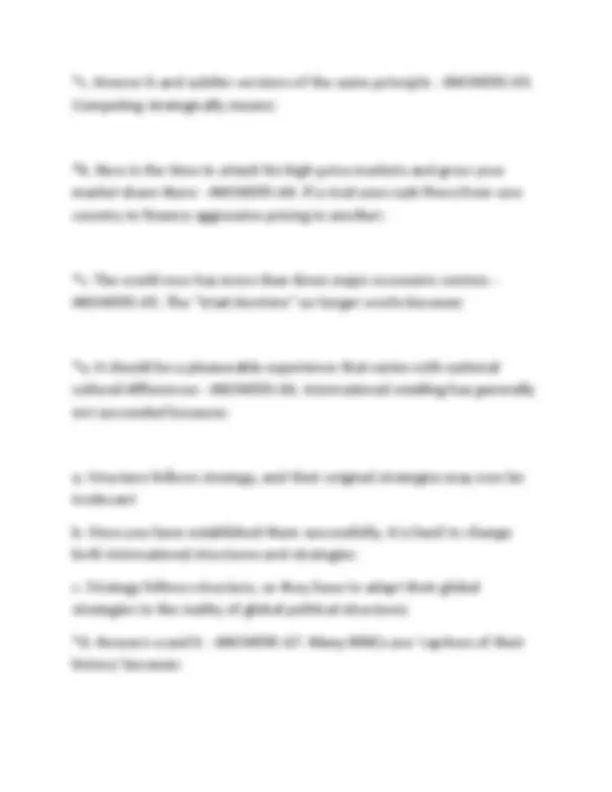
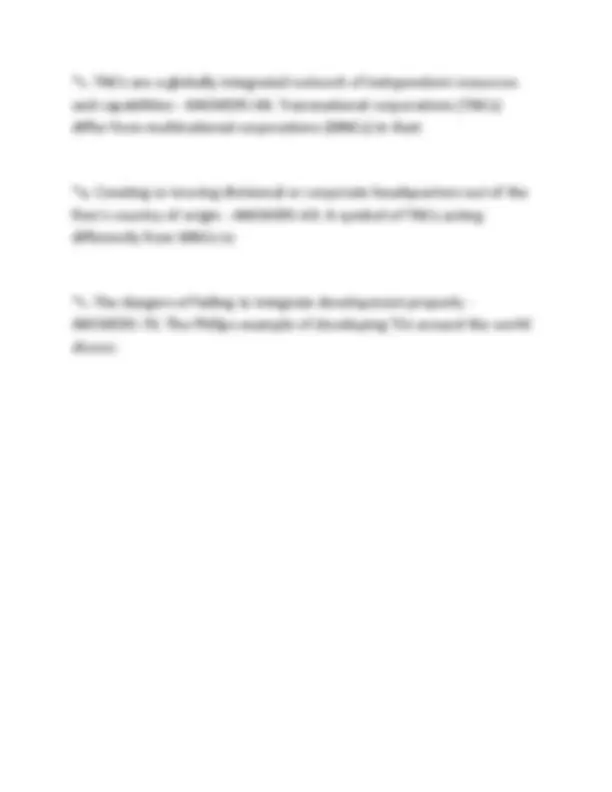


Study with the several resources on Docsity

Earn points by helping other students or get them with a premium plan


Prepare for your exams
Study with the several resources on Docsity

Earn points to download
Earn points by helping other students or get them with a premium plan
Community
Ask the community for help and clear up your study doubts
Discover the best universities in your country according to Docsity users
Free resources
Download our free guides on studying techniques, anxiety management strategies, and thesis advice from Docsity tutors
A comprehensive set of multiple-choice questions and answers covering key concepts in management, including porter's national diamond, industry life cycle analysis, and the characteristics of public sector organizations. It offers a valuable resource for students preparing for a final exam in a management course.
Typology: Exams
1 / 27

This page cannot be seen from the preview
Don't miss anything!




















a. Management, developed capital markets and an efficient legal system
b. A large home market, and good transport and communication facilities
c. Large military forces and a space capability
*d. Answers a and b - ANSWERS. For a modern country innate resources include:
*a. Determine a country's competitive advantage for a sector - ANSWERS- Porter's national diamond identifies some factors that:
a. Strategy, structure and rivalry, such as intense domestic competition
b. Factor conditions, such as the scarcity or abundance of certain resources
c. Related and supporting industries, such as clusters of complementary or supporting industries
*d. All of the above - ANSWERS- Besides demand conditions the other factors in Porter's national diamond are:
a. Policymakers, such as politicians and civil servants
b. The Boards of companies when deciding where to locate their major resource centers (Corporate HQ, R&D labs, Marketing etc.)
c. Venture Capitalists when influencing where a start-up company should locate itself
*d. All of the above - ANSWERS- The people who might profitably use a Porter's national diamond analysis are:
*c. Exporting firm-specific competitive capabilities from home territory requires close attention and may not even be possible - ANSWERS- When considering where to locate production globally:
a. Some products or services are almost impossible to export or import
b. Some goods have to be produced where they are consumed: eating a meal in a restaurant would be a good example
*c. Answers a and b both illustrate the idea of tradability - ANSWERS- Tradability refers to the idea that:
*b. May never enter the decline phase, in some industries supplying basic essential products or services - ANSWERS-31. An industry life cycle:
a. It did not exist at all prior to this time
b. The introduction phase was typical: no mass market, many product variants, small firms
C. By the 1980's, the growth phase had begun, with a design standard emerging
*D. All of the above - ANSWERS-32. The PC industry clearly began in the 1970's because:
*b. IBM had seen the PC as a tiny, hobbyist's niche within the computer industry, not worth IBM's attention - ANSWERS-33. IBM initially ignored the PC market because:
a. Did so with a maverick offshoot, and by buying in sub-systems, which went against the IBM usual methods
b. Suffered slow growth since they were late to market
c. Relied on business users recognising the established IBM reputation
*d. Answers a and c - ANSWERS-34. When IBM did enter the PC market, they:
a. IBM established a dominant design
b. IBM had an established access to the business market, which Apple et al did not have
c. IBM opted to encourage 3rd parties to write software and provide additional hardware, unlike Apple
*d. All of the above - ANSWERS-35. The essence of IBM's success in the PC industry in the 1980's was:
a. Massive and unpredictable
b. Gradual and predictable
*c. Could be either answer a or b, depending on the industry and the prevailing conditions - ANSWERS-21. Change in the industry environment faced by a firm is:
*b. Both external forces and the incumbents' competitive strategies - ANSWERS-22. Change in an industry is the result of:
*c. Understand, predict, manage change, and adapt its strategy to it - ANSWERS-23. Regarding change, a firm really needs to:
a. Is an extension of the concept of the product life cycle
*d. Answers a and b - ANSWERS-37. Is the PC industry in the maturity stage of the life cycle?
*b. Change in every major aspect e.g. product evolution, the nature of competition - ANSWERS-38. As the industry life cycle progresses, overall strategies need to:
*b. de novo entrants - ANSWERS-39. Start-up firms in a new industry are also sometimes known as:
*c. de alio entrants - ANSWERS-40. Firms entering a new industry who were already established in a related industry are sometimes known as:
*a. Effective product innovation - ANSWERS-41. The basis of entering a new industry at the Introduction phase is:
*a. Interacts across the world from the outset - especially regarding selling - ANSWERS-42. A "born global" company is one which:
*b. Needs to be closely associated with the dominant design which emerges - ANSWERS-43. Often, to succeed in the evolution from Introduction to Growth a firm:
a. Offer a product or service which is designed to be "scaled up" in volume
b. Obtain sufficient resources and build capabilities to support effective scaling-up of operations
c. Have sufficient market access or commercial muscle to sell scaled-up volume
*d. All of the above - ANSWERS-44. To succeed as a leading player in the Growth phase a firm should:
*b. Operate as a specialist, niche player, thus avoiding the necessity to fully "scale up" - ANSWERS-45. To survive the Growth phase profitably a firm NOT having all the attributes of a leading player could:
*c. Emphasise cost efficiency - ANSWERS-46. To survive going into the Maturity phase of the industry life cycle a firm needs to:
*b. Tends to decrease significantly - ANSWERS-47. With the onset of the maturity stage, the number of firms in most industries:
*b. The middle-sized companies - ANSWERS-48. With maturity, the type of firms who fail to survive are typically:
a. Technological substitution e.g. the horse and cart replaced by the car
*b. Maintaining cost efficiency as good as competitors - ANSWERS-54. The key success factor for firms surviving in the Maturity phase is:
a. They are owned by the government
b. They are wholly or partly government-funded
c. They often provide a service at price well below that of an equivalent private sector firm
*d. All of the above - ANSWERS-55. Public sector firms differ from private sector firms in that:
*a. Services which cannot be provided by the private sector e.g. an army for defence - ANSWERS-56. In some cases, public sector organisations provide:
*b. Have stakeholders some of whom are obliged by law to act in the national or public interest - ANSWERS-57. Public sector organisations:
*c. Often do make profits (called a surplus), but these are re-invested in the organisation - ANSWERS-58. Not-for-profit organisations:
a. Shaped by political considerations
b. Multiple, often conflicting and shifting
c. Lacking the overriding obligation to return a profit to shareholders
*d. All of the above - ANSWERS-59. The aims, goals and objectives of public sector firms are characteristically:
a. The absence of a market e.g. the police
b. A legally enforced monopoly
c. Heavily unionised workforces
*d. Answers a and b - ANSWERS-60. Further characteristics of -some not all - public sector organisations include:
*c. Public sector organisations are often legally obliged to take a wide spectrum of stakeholders' views into account - ANSWERS-61. Stakeholder analysis for public sector organisations is particularly important because:
*a. Identifying, understanding and prioritizing the needs of stakeholders - ANSWERS-62. Stakeholder analysis in the public sector is about:
*d. Easily constructing alternative plausible views of how the world may look, often in the more distant future eg 25 years - ANSWERS-63. Scenario planning is a tool for:
*d. All of the above - ANSWERS-36. The main concepts to determine the scope of a firm's activities are:
a. Economies of scale refer to cost-advantage from higher volume of a single product
b. Economies of scope refer to cost-advantage from spreading a common cost over multiple products
*c. Answers a and b - ANSWERS-37. Economies of scope and economies of scale both relate to lower average cost but:
*b. Expand the scope of its activities in some relevant way - ANSWERS-
*d. It IS still true for brand extension, since creating and maintaining a brand does cost a lot e.g. in advertising - ANSWERS-39. Although economies of scope refer to spreading cost, this is not the case for brand extension:
*b. Potential for economy of scope based on organisational or managerial capability - ANSWERS-40. A company in a mature industry which is good at cost-reduction is exhibiting:
*b. The invisible hand - ANSWERS-41. Adam Smith, the famous economist, called the market mechanism:
*a. Whether the transaction costs of buying in the activity in the market exceed the administrative cost of doing it themselves - ANSWERS-42. A significant determining factor on whether a firm conducts an activity internally is:
a. The need for managers to understand a wider range of businesses
b. The need for managers to operate differently to succeed in different businesses
c. The extent of the linkages between the various businesses
*d. All of the above - ANSWERS-43. Increased corporate complexity because of expanded scope is caused by:
*c. Not always as unrelated as it may seem e.g. the businesses may share some common attributes which can be exploited - ANSWERS-44. A strategy of unrelated diversification is:
*a. Growth, risk reduction and value creation - ANSWERS-45. The most often cited benefits of diversification are:
*a. Despite the cost-savings, poor investment decisions tend to be made - ANSWERS-52. A major problem associated with internal capital markets is:
*c. Employees can be transferred rather than hired / fired, and the firm knows these people well - ANSWERS-53. An advantage of diversification is a better internal labour market because:
*b. Be able to see a way to make superior profits in that industry - ANSWERS-54. Michael Porter's "attractiveness test" means that a firm considering diversifying into another industry should:
*d. The "better-off" test - ANSWERS-55. Of Michael Porter's 3 tests of whether a proposed diversification will create value, the most important one is usually:
*a. Tends to be particularly unsuccessful - ANSWERS-56. Mergers and acquisitions are frequent. Diversifying into another industry this way:
*b. A trend for diversified firms to refocus and reduce their diversification - ANSWERS-57. Over the past 30 years, the tendency in the USA and Europe has been:
*c. It moves to own more stages of the value chain, either upstream or downstream of its core activity - ANSWERS-58. A firm becomes more vertically integrated when:
*c. De-integration or disaggregation - ANSWERS-59. Outsourcing is a form of:
*b. Because in some industries the conditions favouring further vertical integration outweigh the benefits of focusing and outsourcing - ANSWERS-60. The move over the past 25 years to refocus and de- integrate has not been universal; some industries have further vertically integrated:
*b. A cost-saving arising from the technicalities of performing integrated processes - ANSWERS-61. A "technical economy" is:
a. There can no longer be a market operating between them for the item concerned
b. There can be an adversarial relationship as each tries to gain advantage
c. There can be strategic benefit, so long as the partners try to jointly maximise their profit in the downstream market
a. The firm has built a capability to respond speedily in a coordinated fashion
b. The firm maintains spare capacity, and can bear spare capacity
c. The market cannot respond as quickly, or capacity is unavailable
*d. All of the above - ANSWERS-68. Vertical integration may afford flexibility in responding to uncertain demand when:
a. Top managers have a complete knowledge of the entire value chain
b. The capital invested and the fixed costs are often much higher for a vertically integrated firm
c. A decline in sales and profits in the end market affects all stages simultaneously
*d. Answers b and c - ANSWERS-69. Full vertical integration compounds risk because:
*a. It depends on the specific factors prevailing - ANSWERS-70. To make a choice between vertical integration or external sourcing, which statement is true?
*c. A long-term agreement with competitors to fix the market price for a commodity product - ANSWERS-71. Which of these choices is NOT an example of a vertical relationship?
*a. Attempts to secure optimum benefits from close collaboration whilst preserving some form of market transaction - ANSWERS-72. A hybrid vertical relationship is one which:
b. Such a company may find it loses the ability to understand the industry it is in
c. A group of suppliers and/or customers may decide to co-ordinate themselves, and isolate the virtual company
*d. Answers b and c - ANSWERS-73. There was a fashionable trend towards "virtual companies" in recent years, who make the largest profits in a value chain by co-ordinating all the other aspects. The risk with this plan is:
*d. Relative market share - ANSWERS-74. Which of these is NOT a factor to be included in "industry attractiveness" in the GE/McKinsey Matrix:
a. It's only based on one variable to judge market attractiveness
b. It's only based on one variable to assess competitive strength
c. It presumes a portfolio of businesses which have little synergy or mutual dependence
*d. All of the above - ANSWERS-75. A major limitation of the BCG Growth-Share Matrix is: